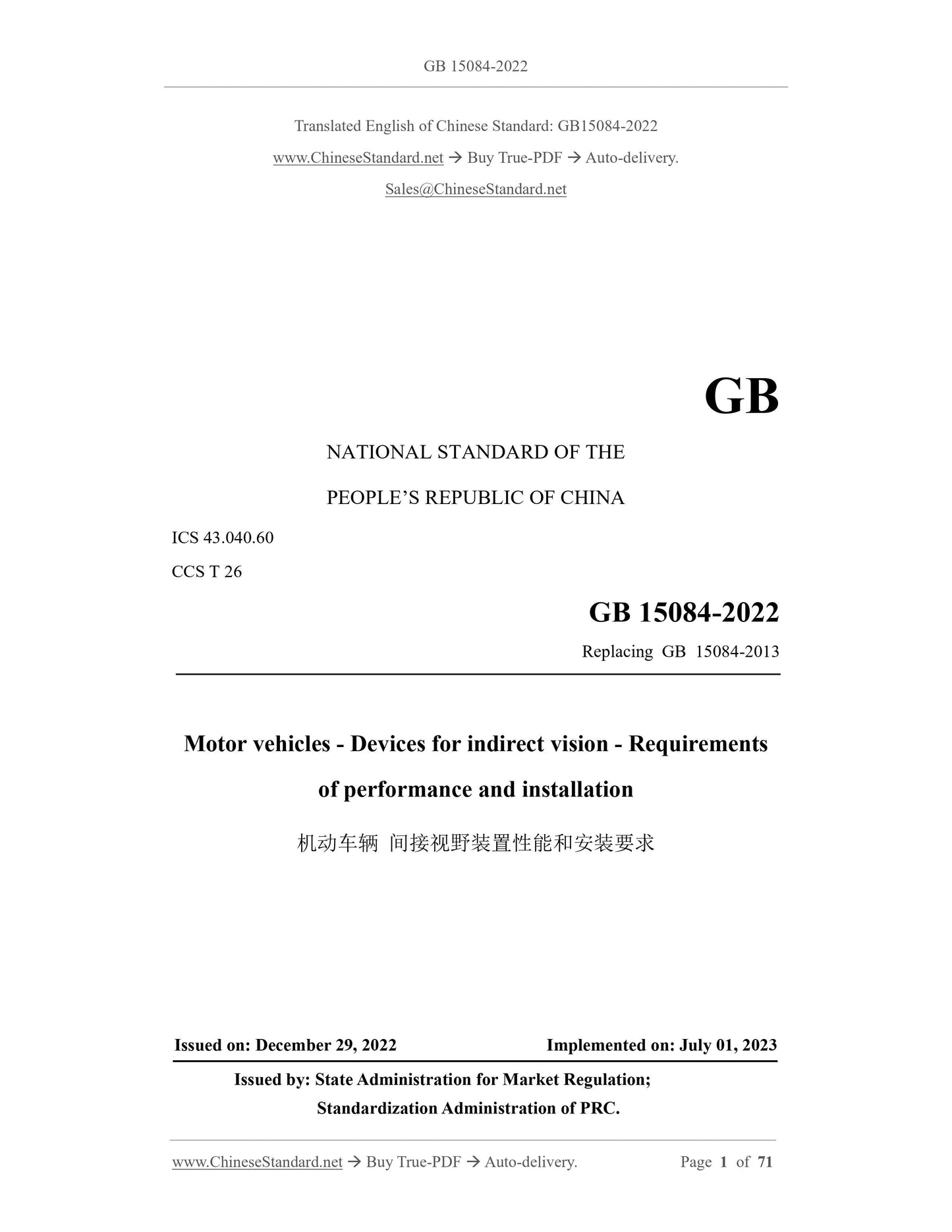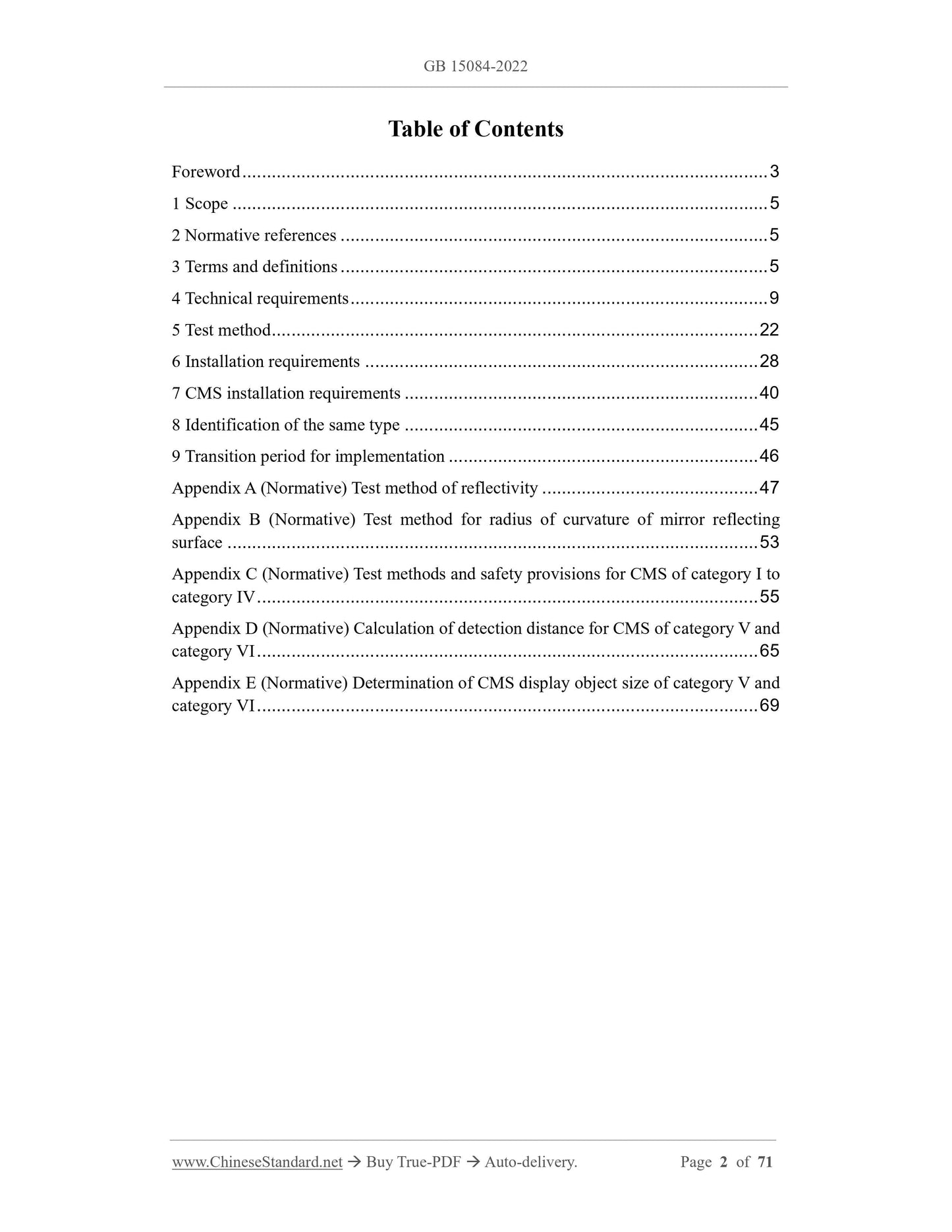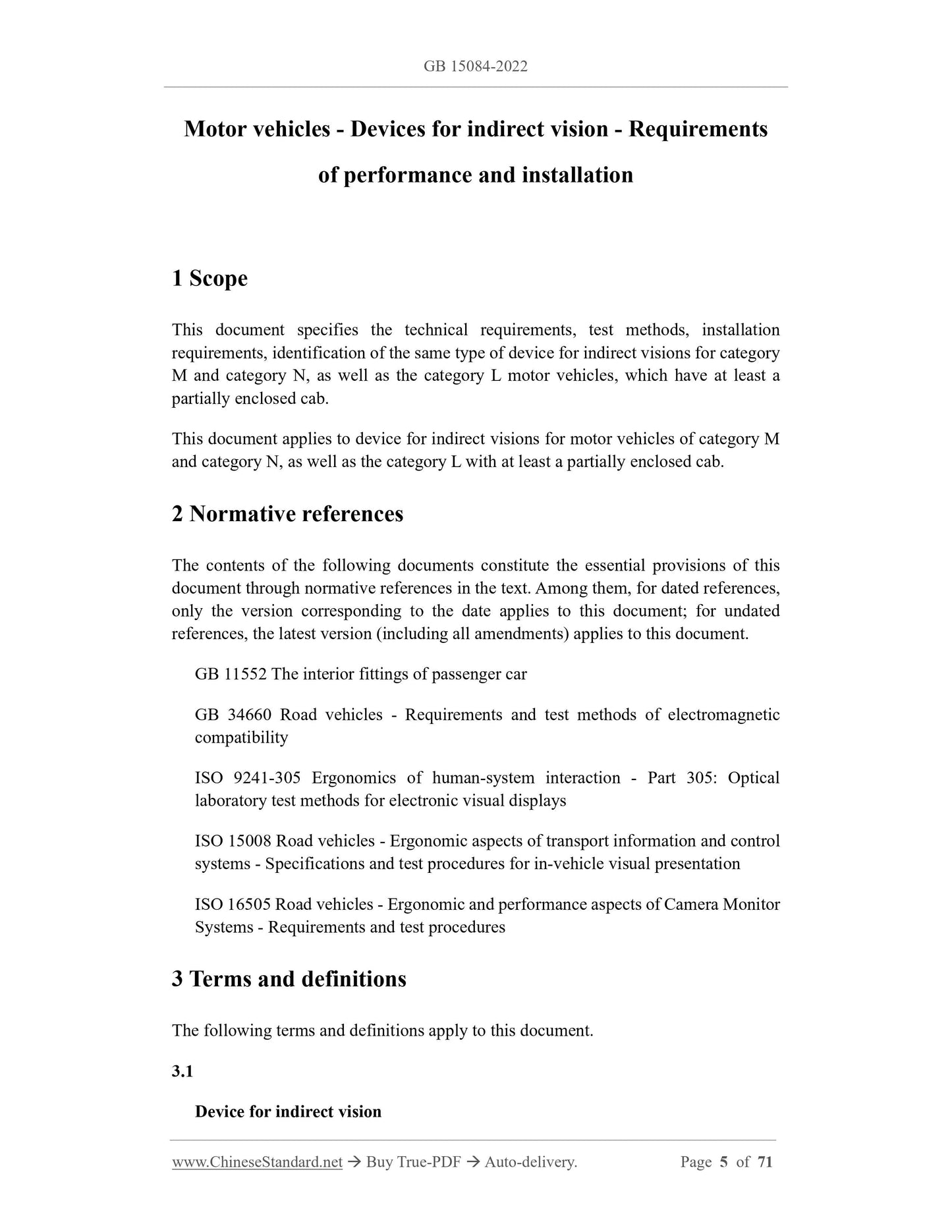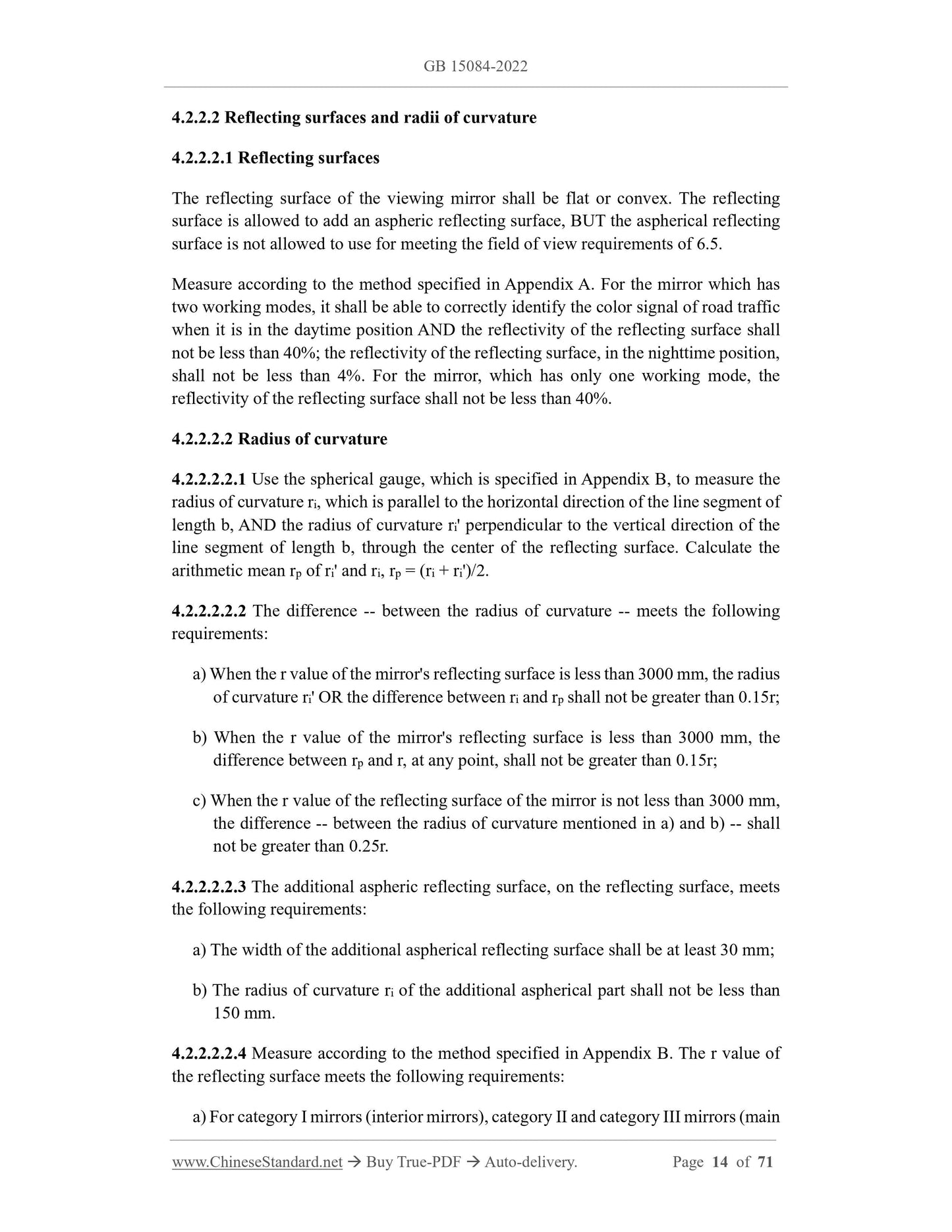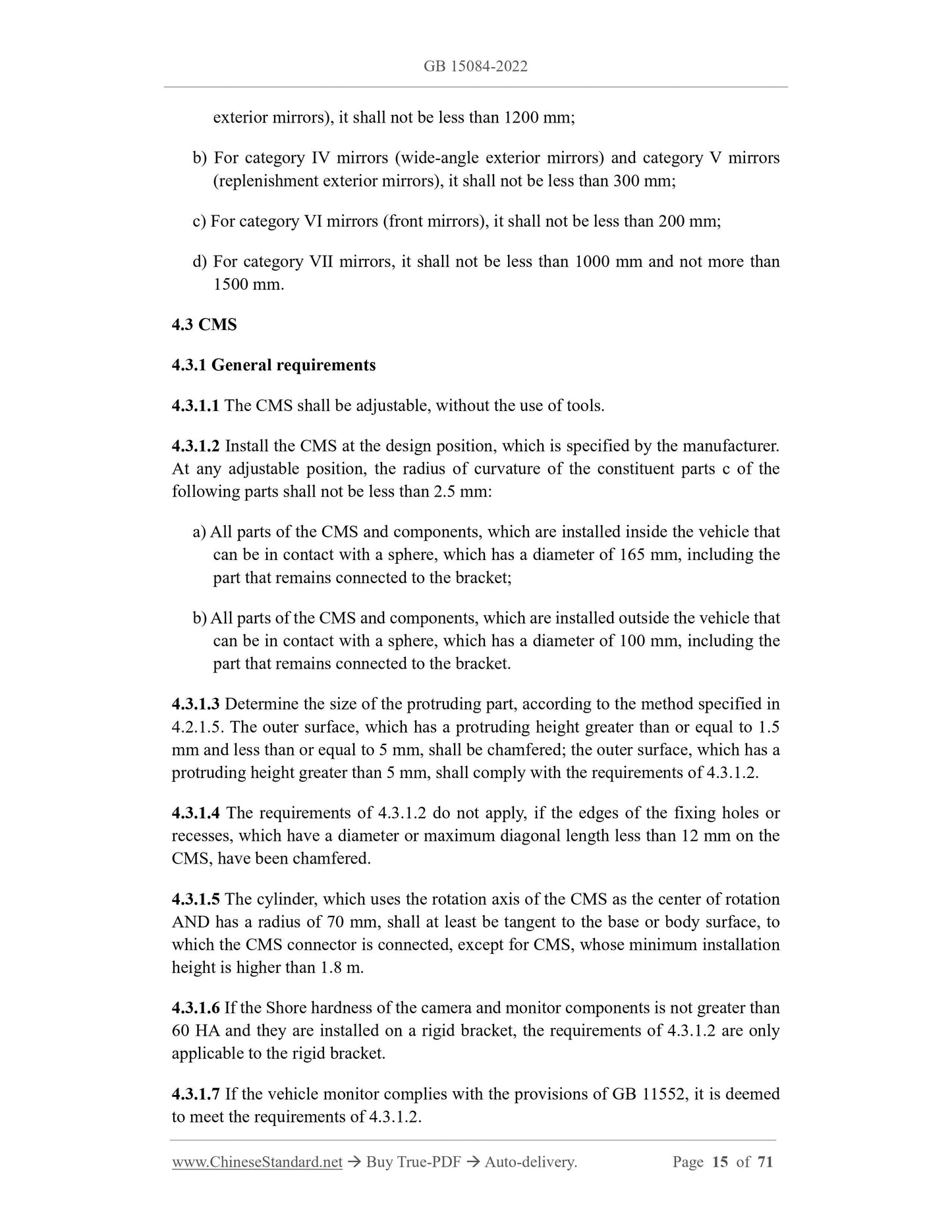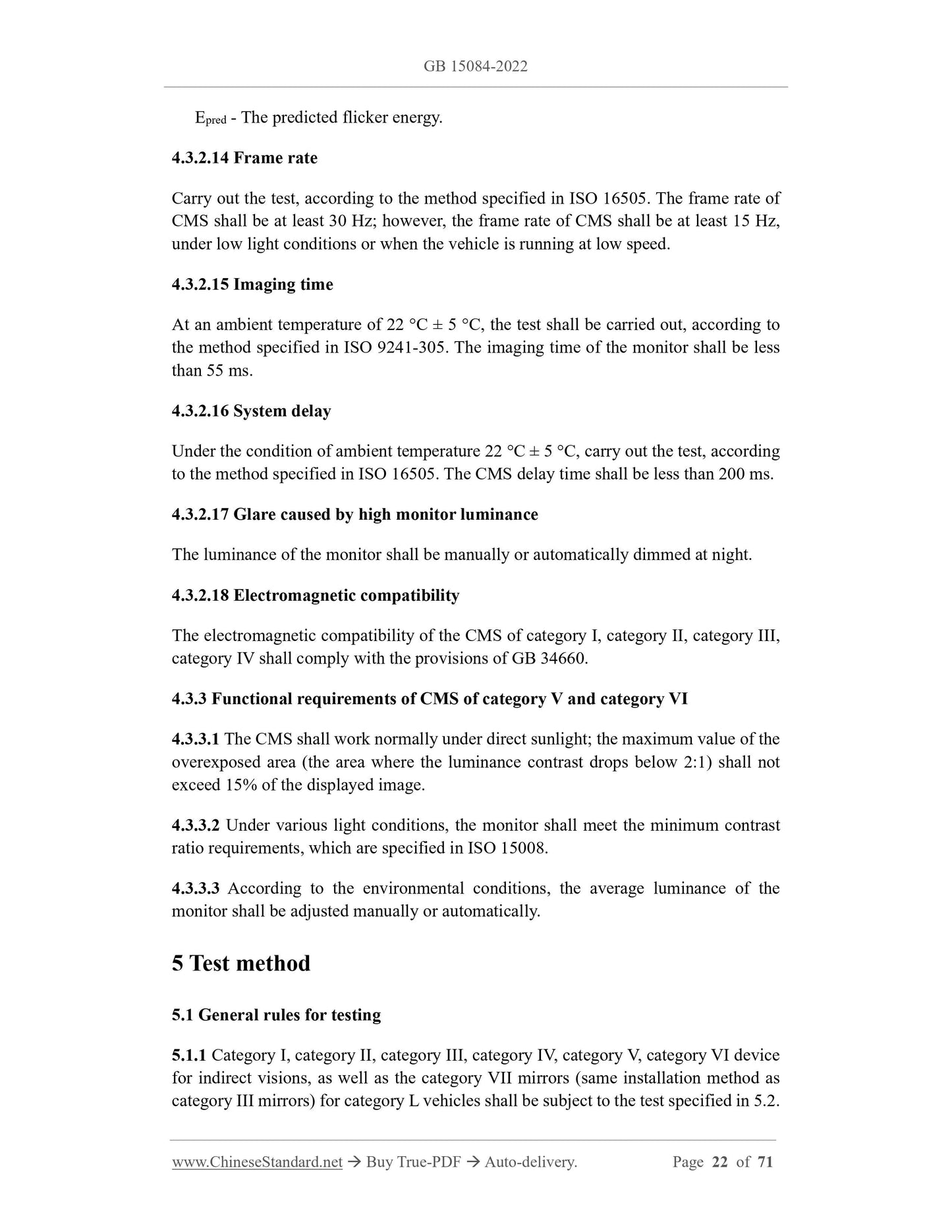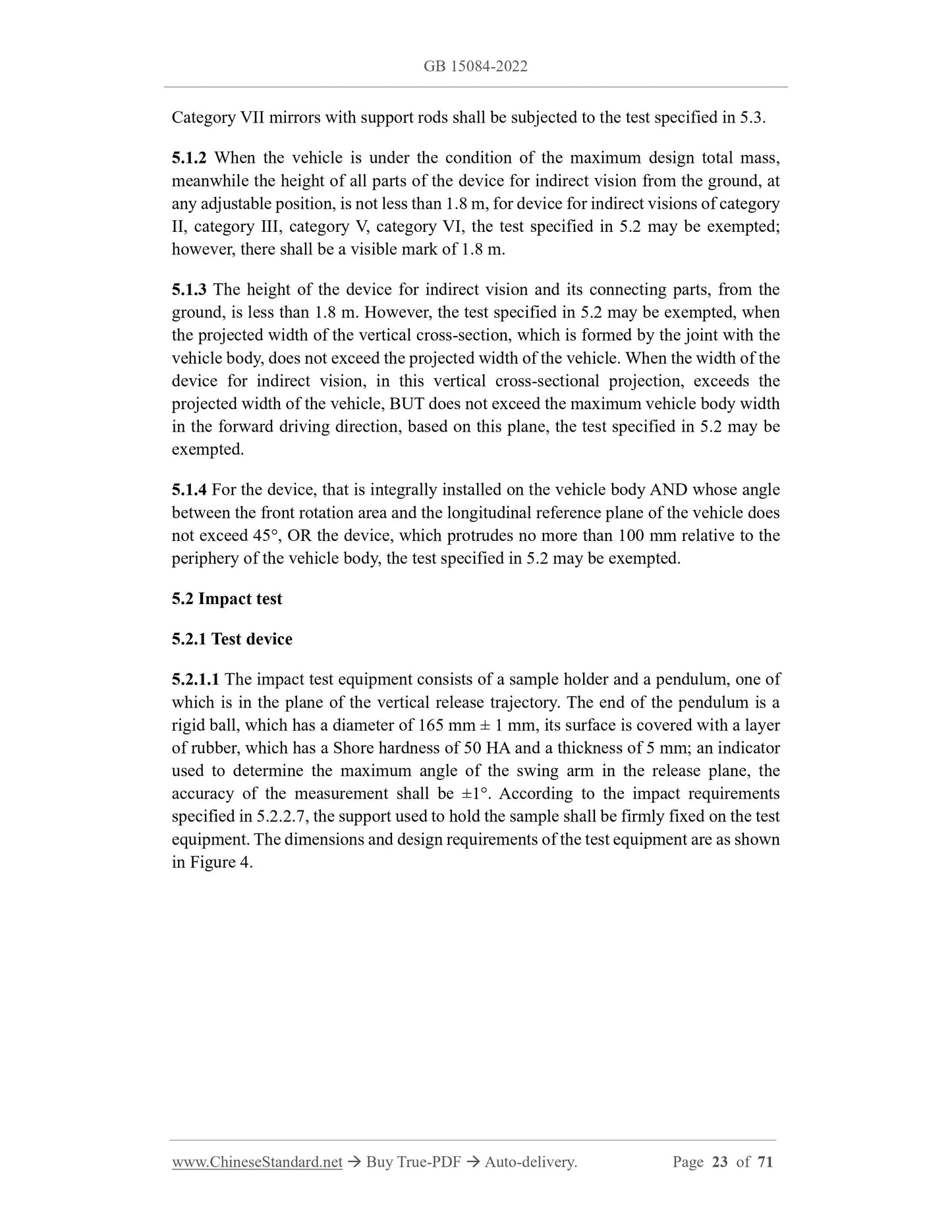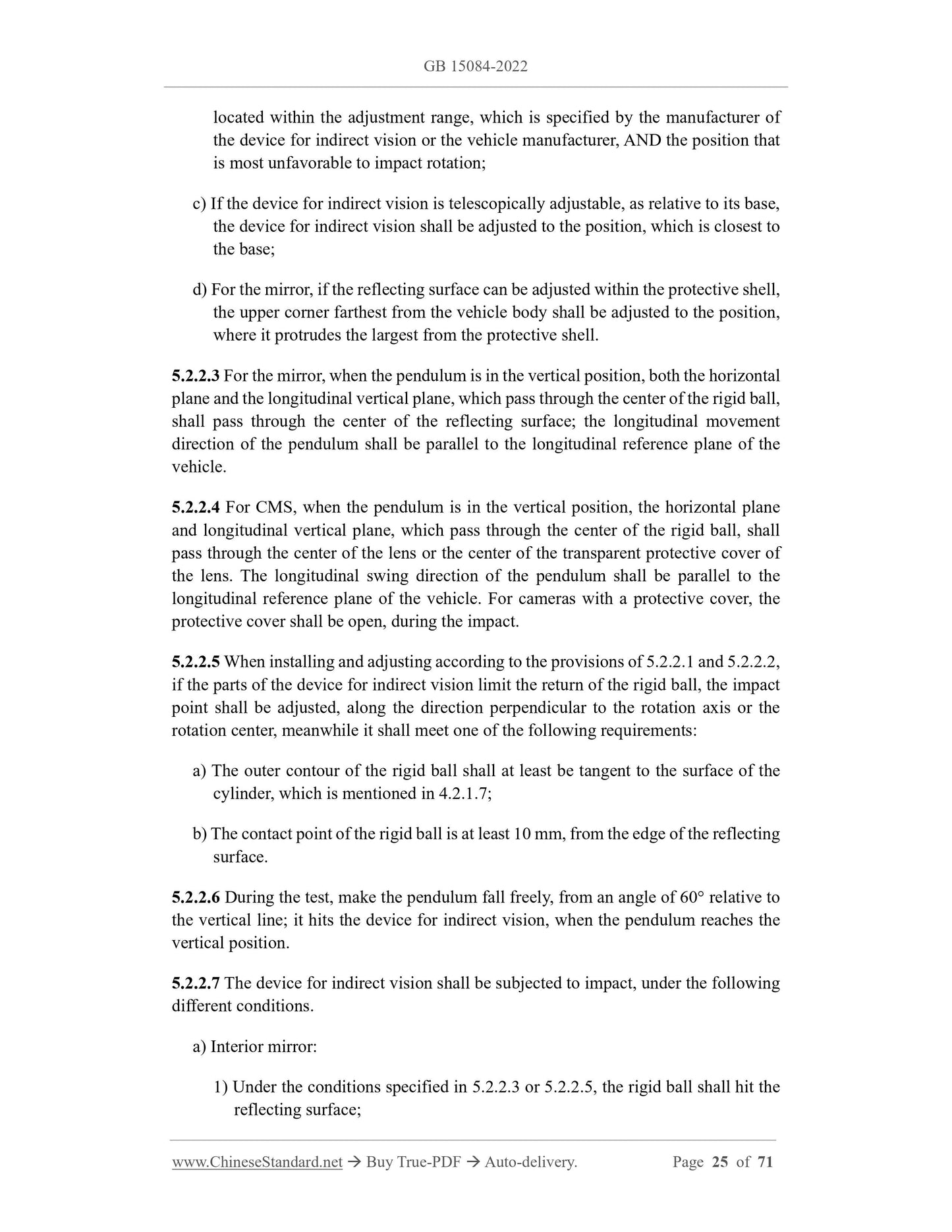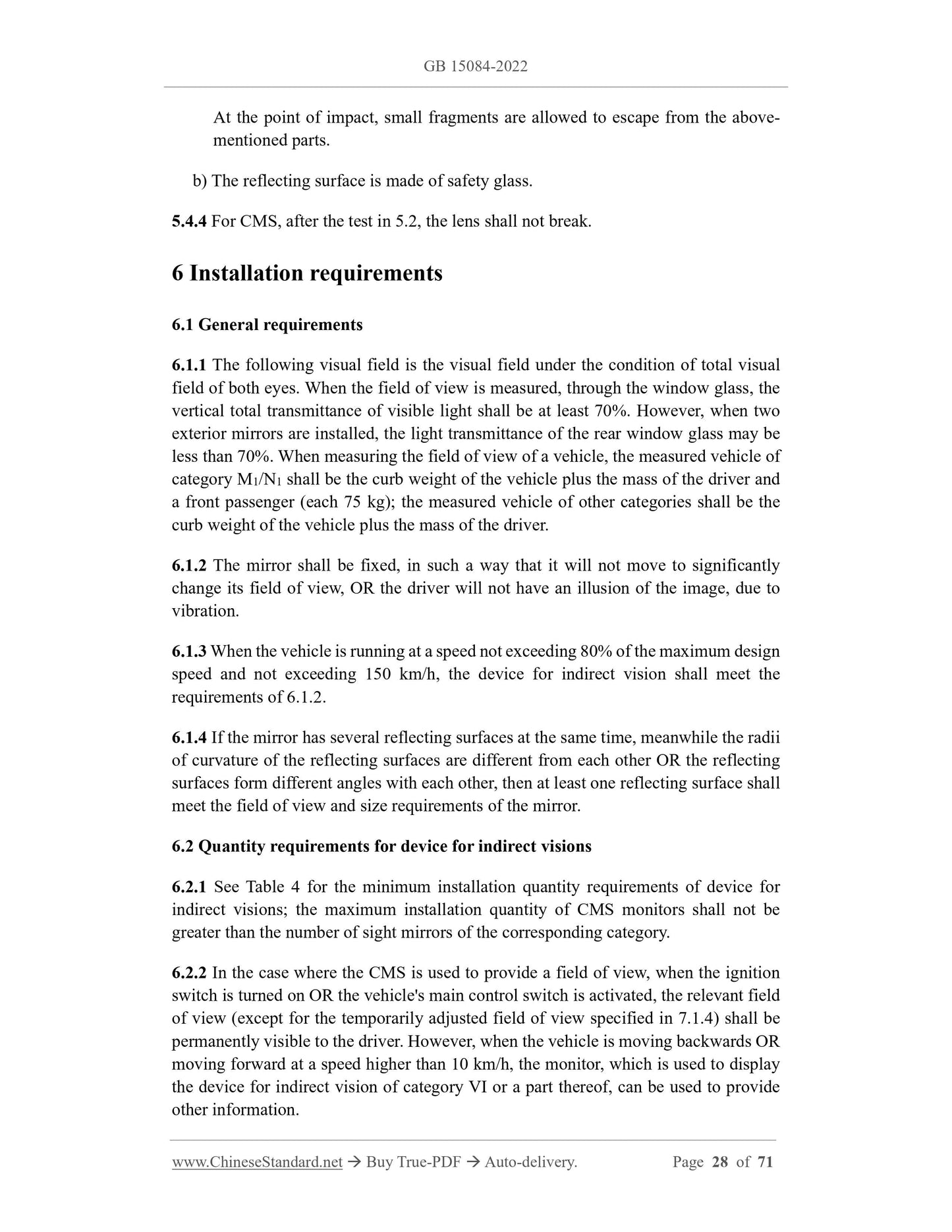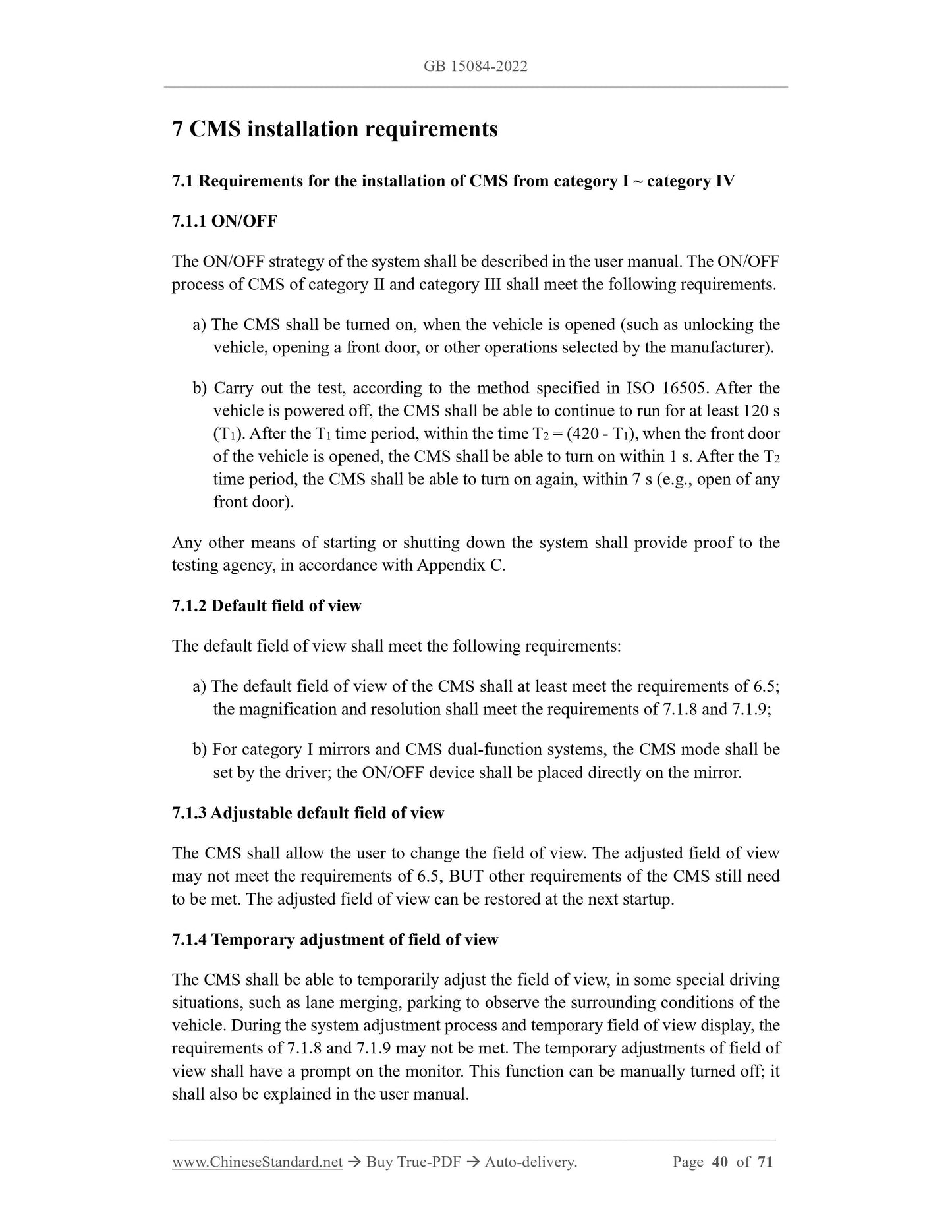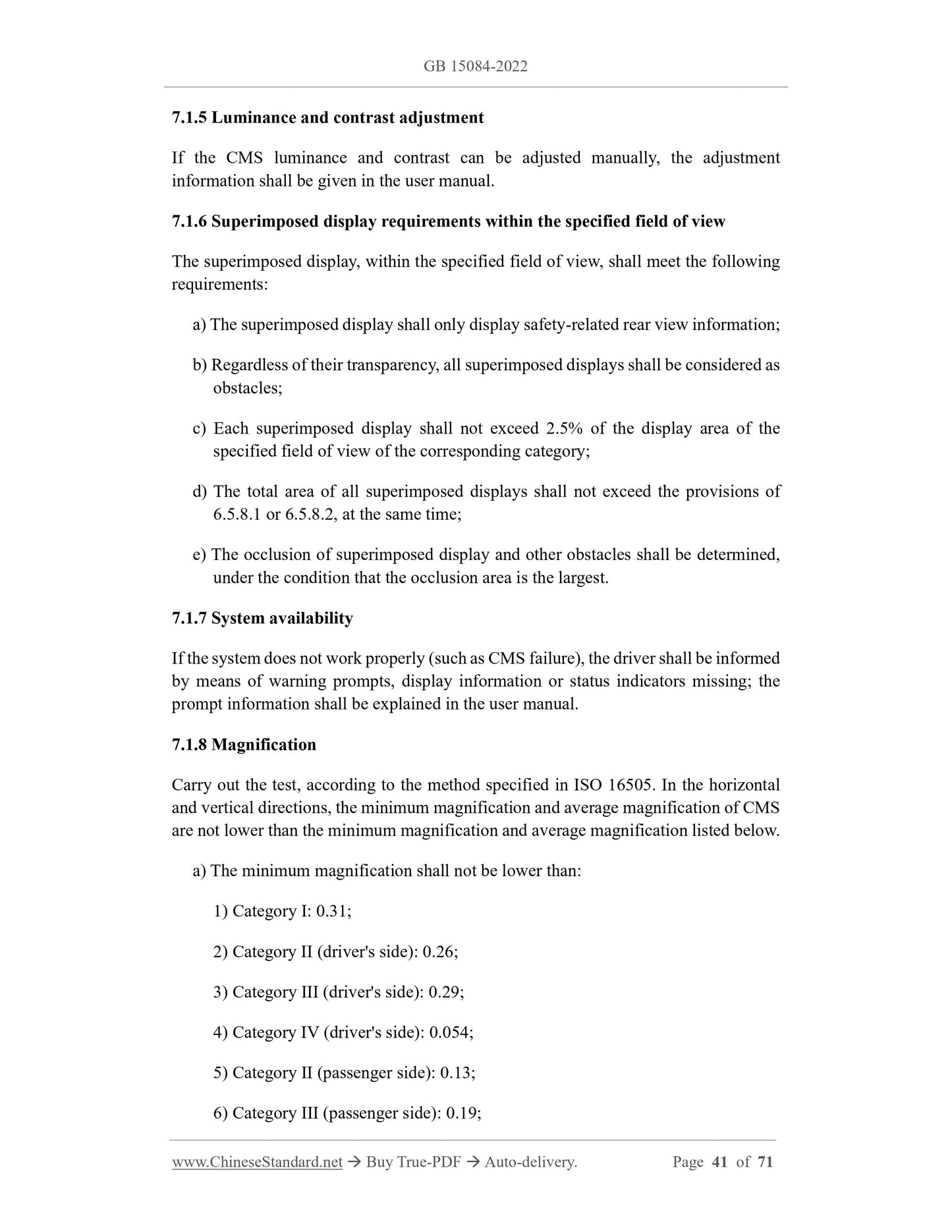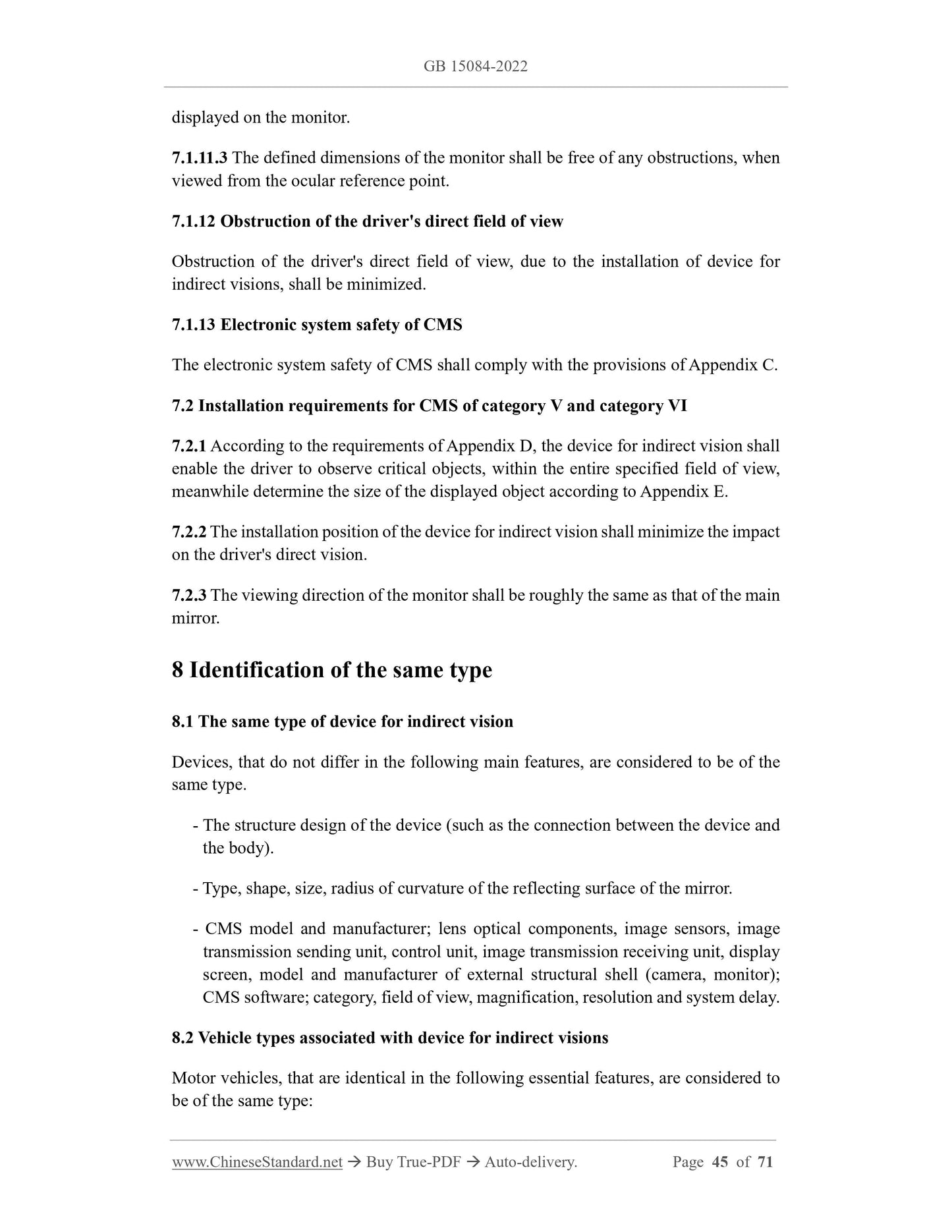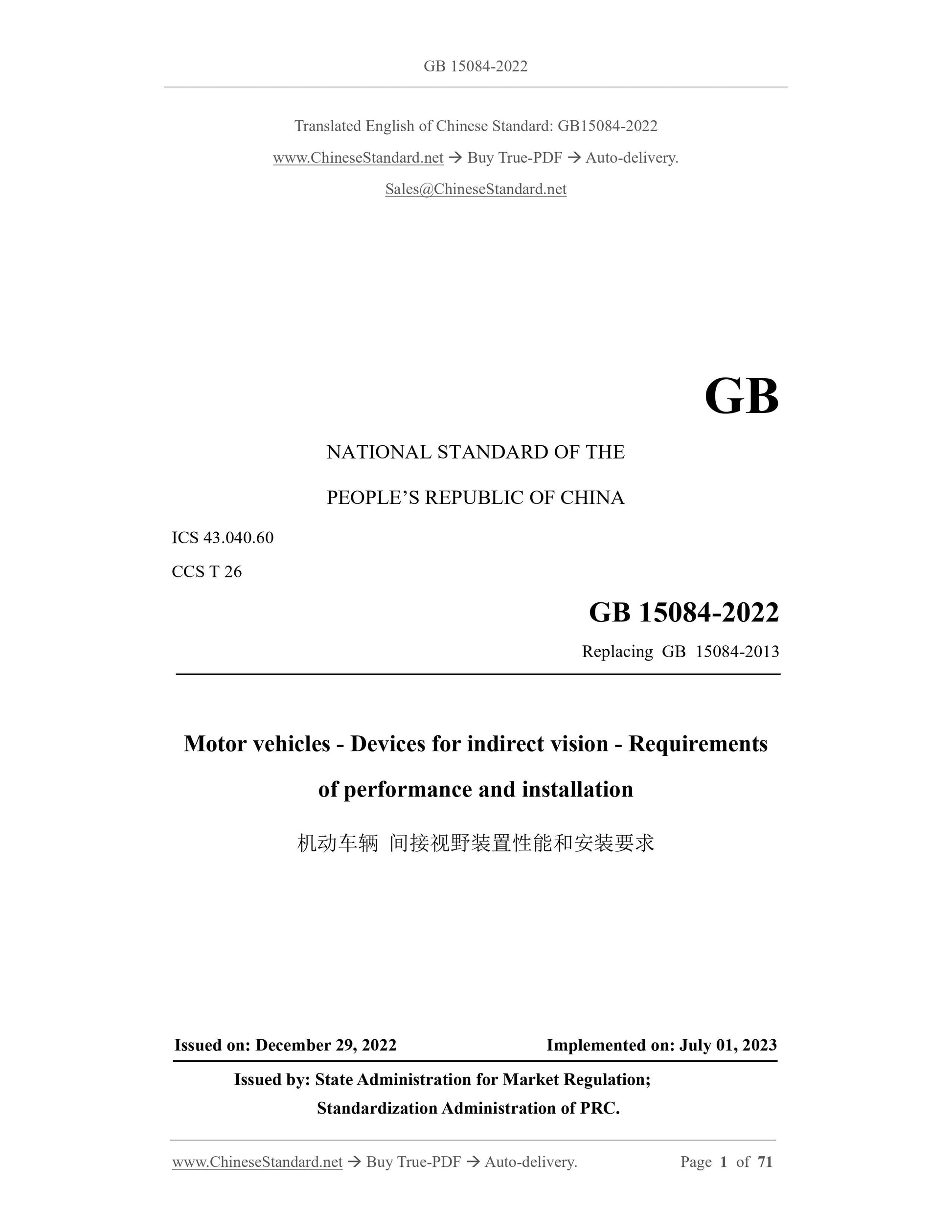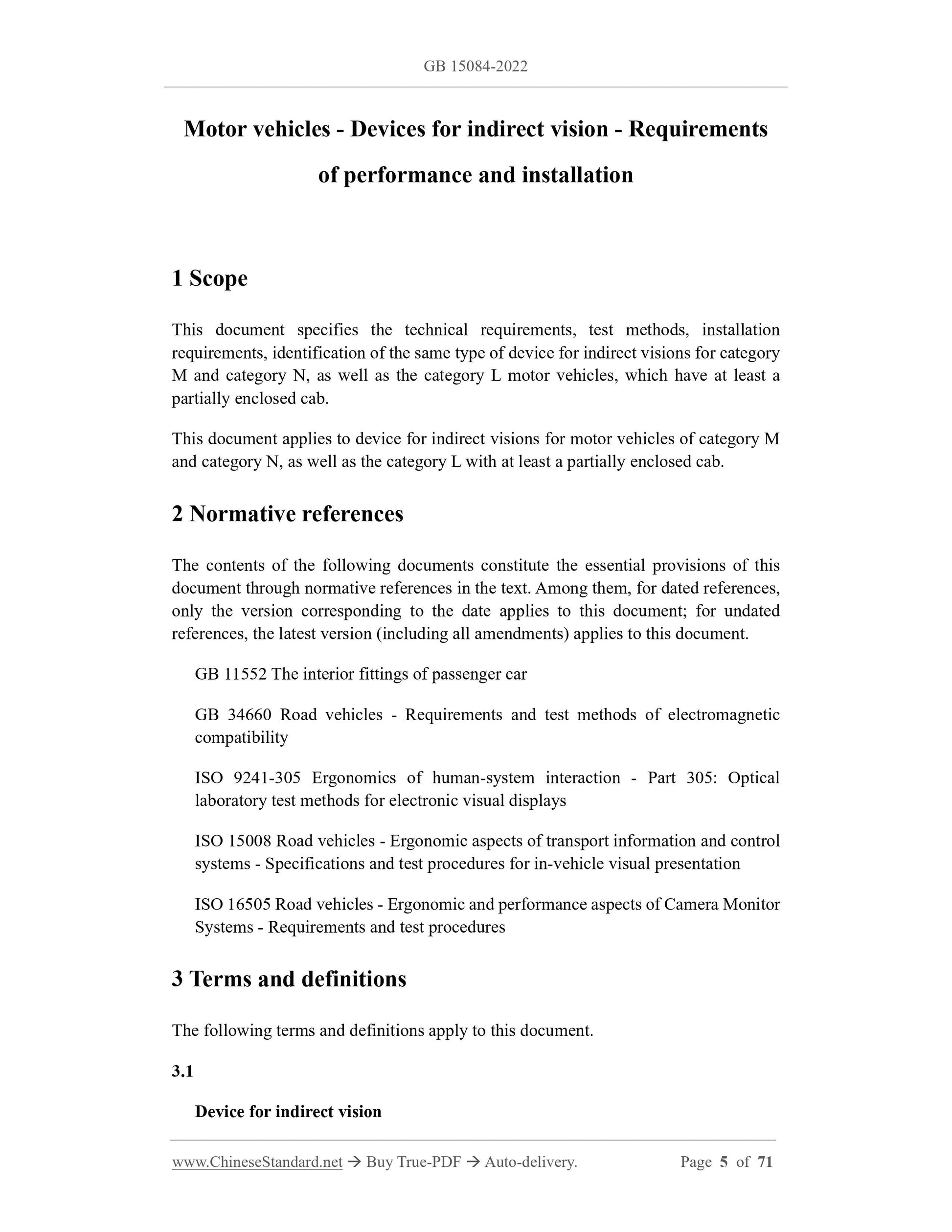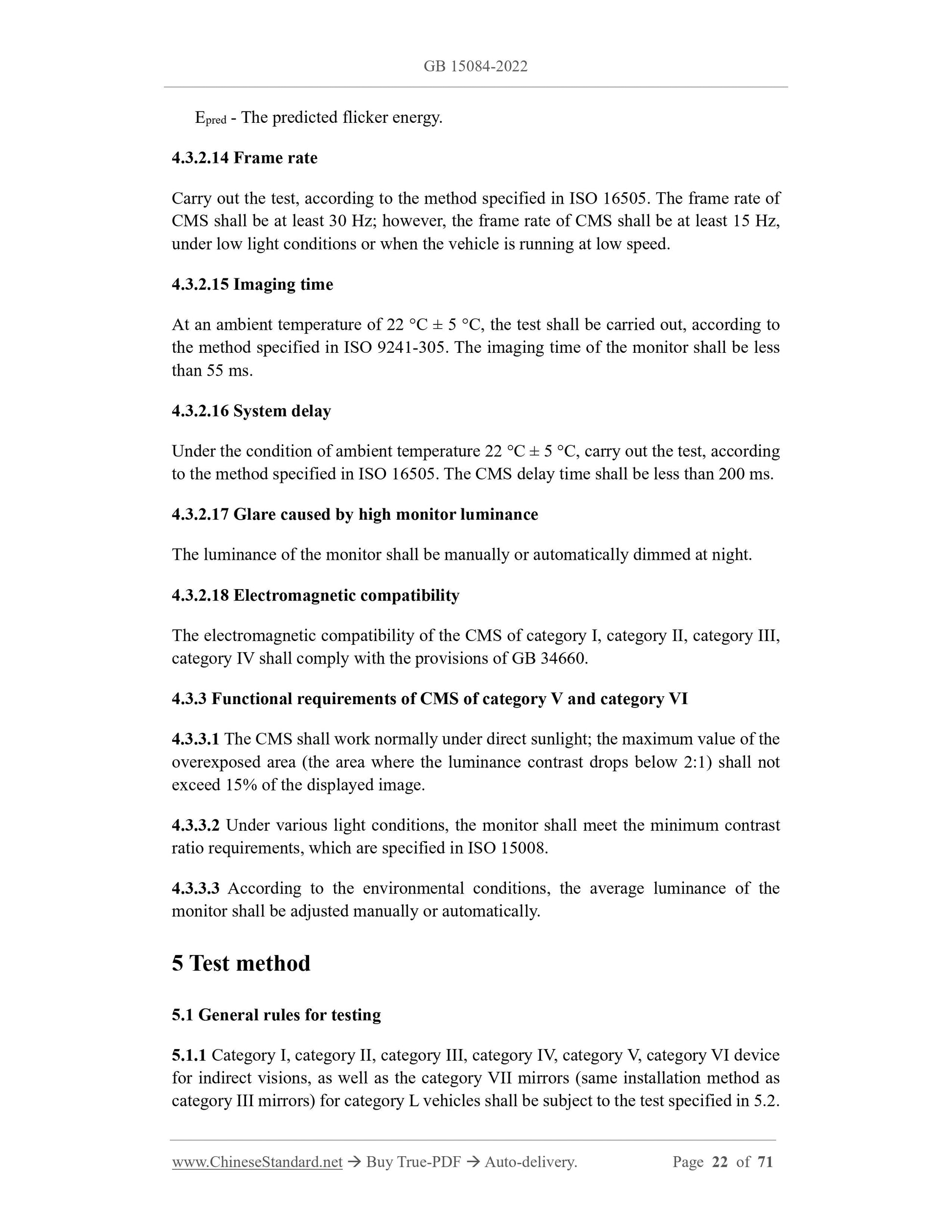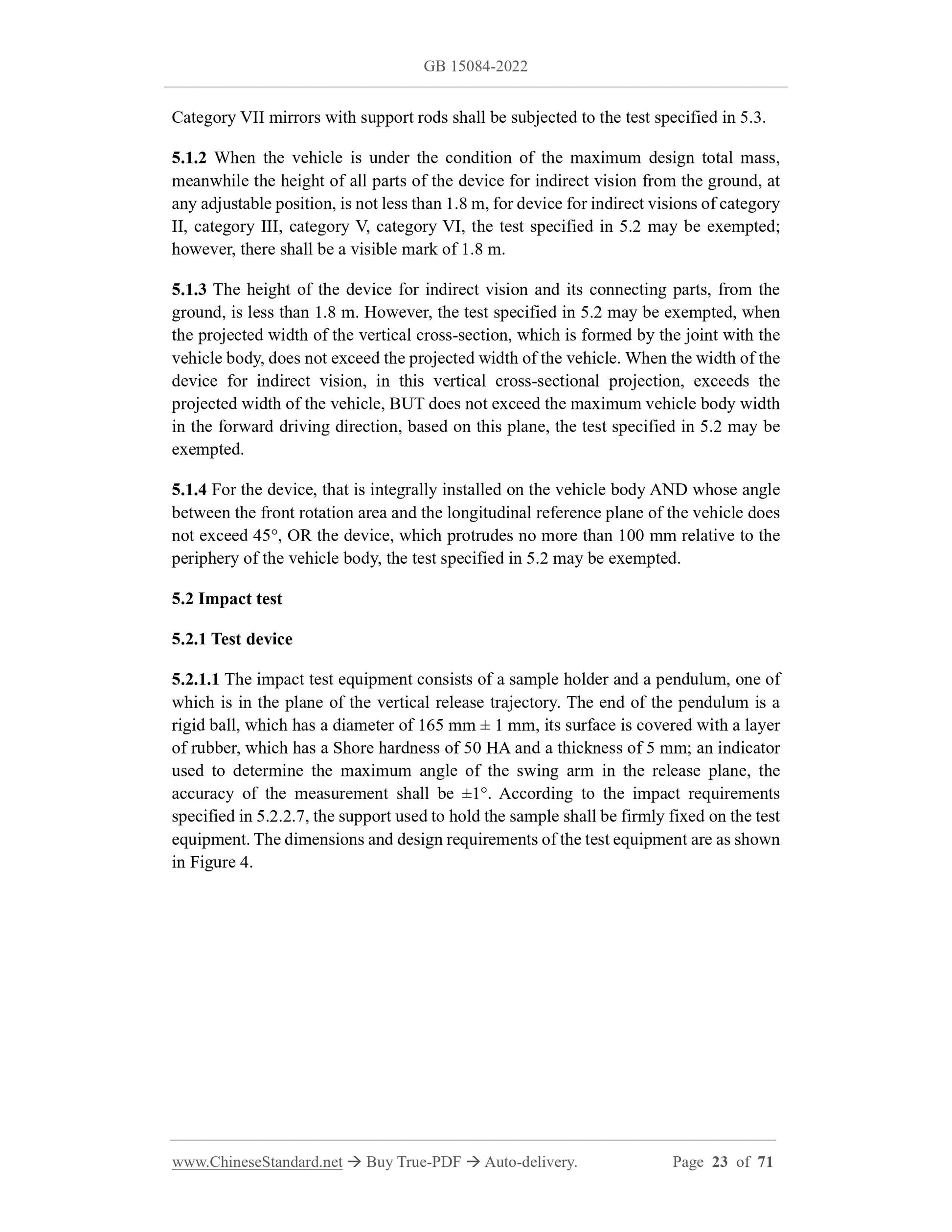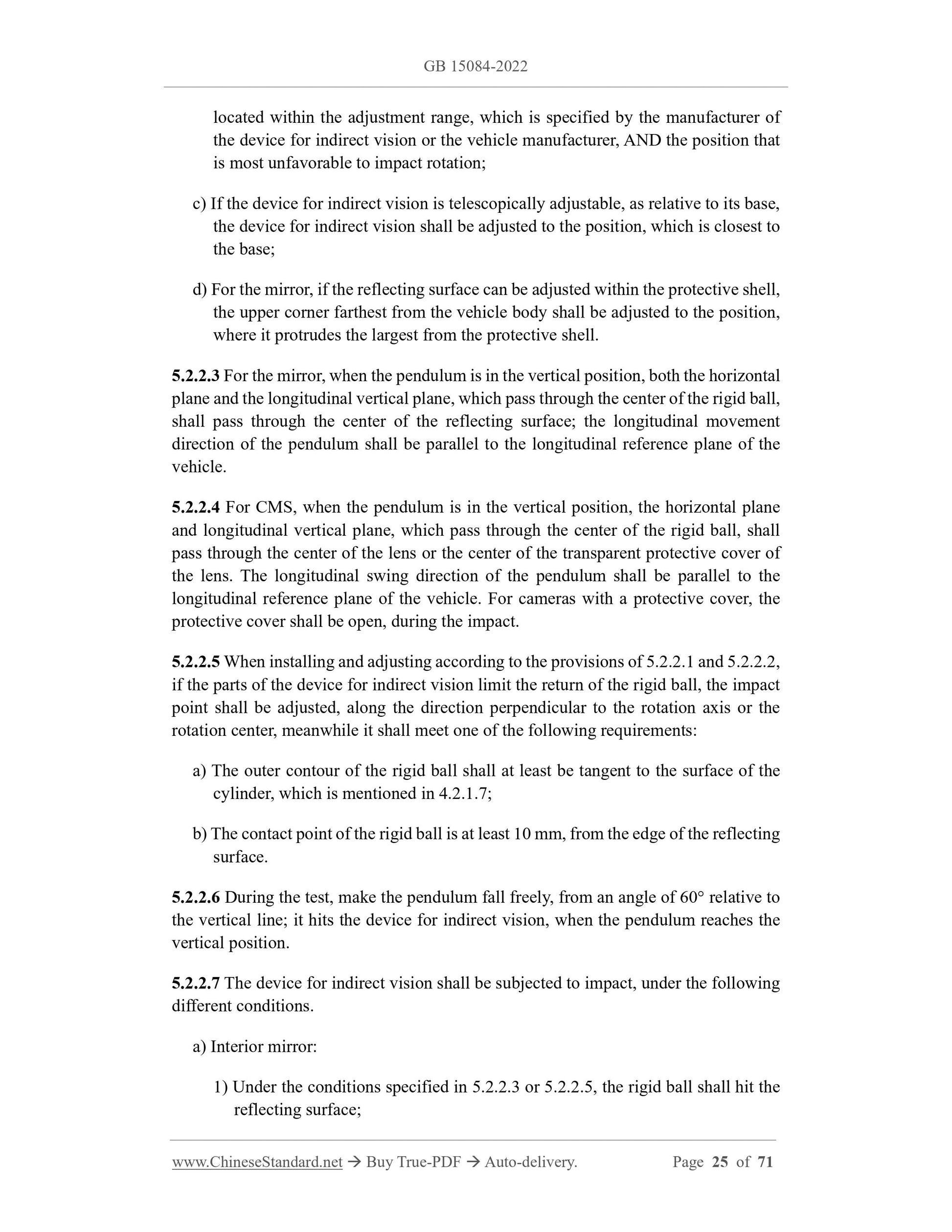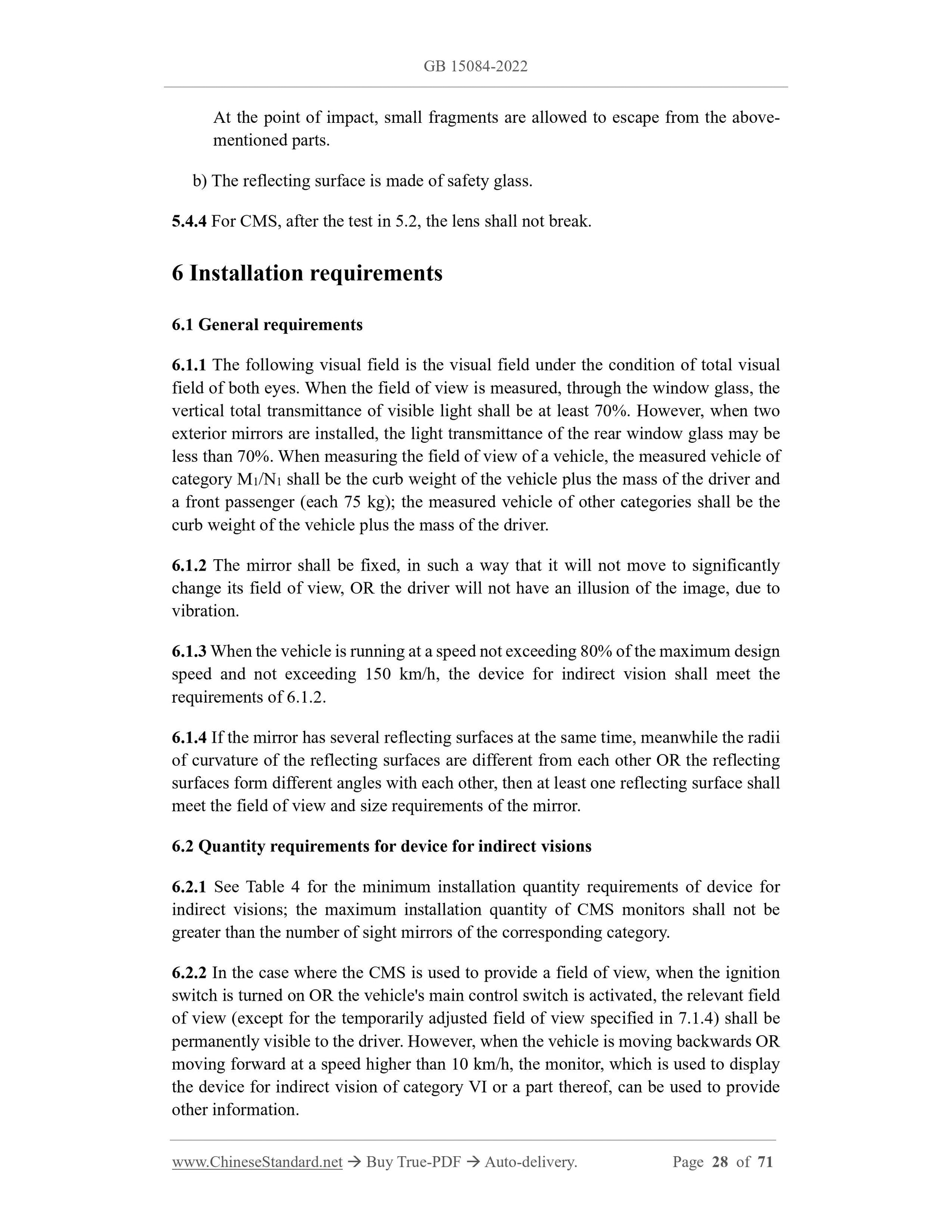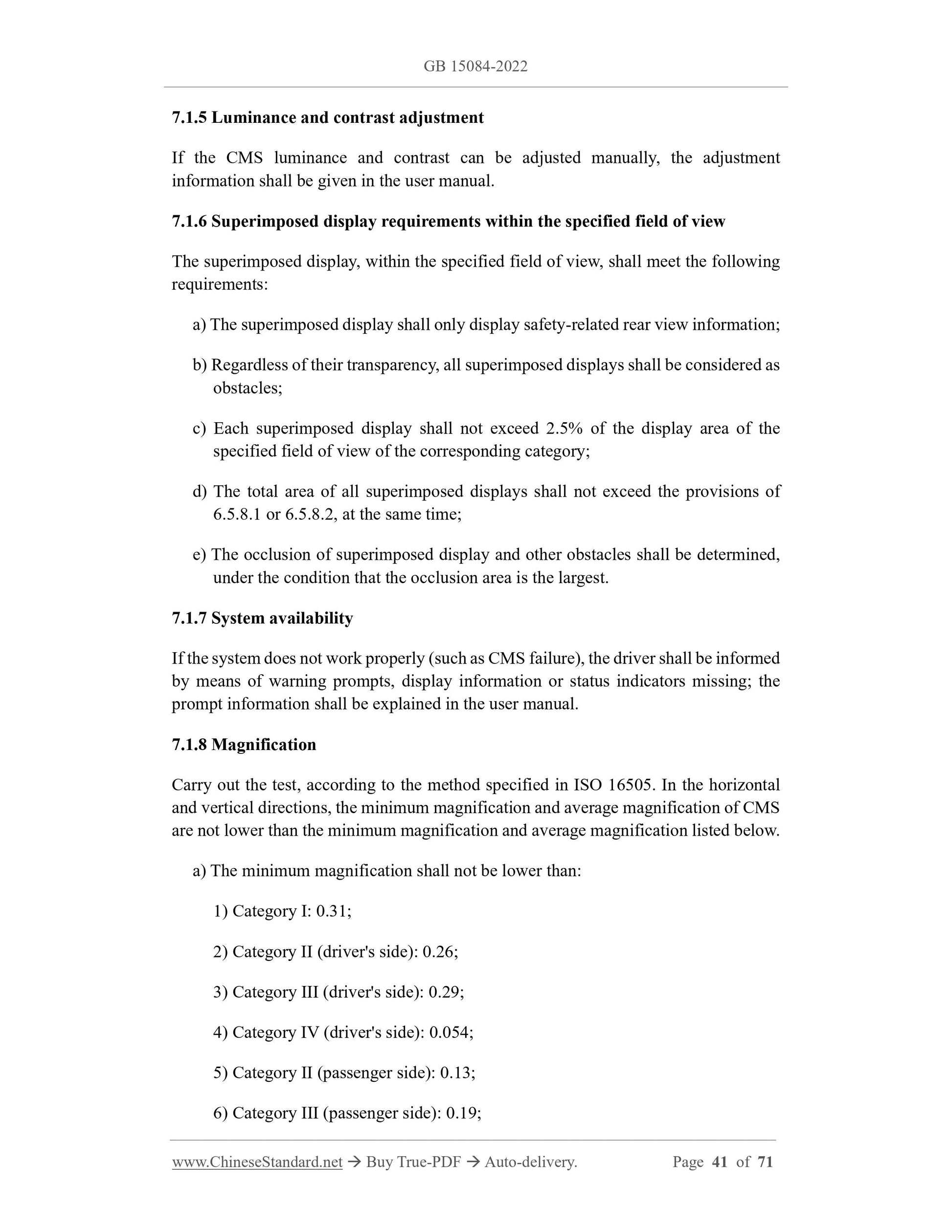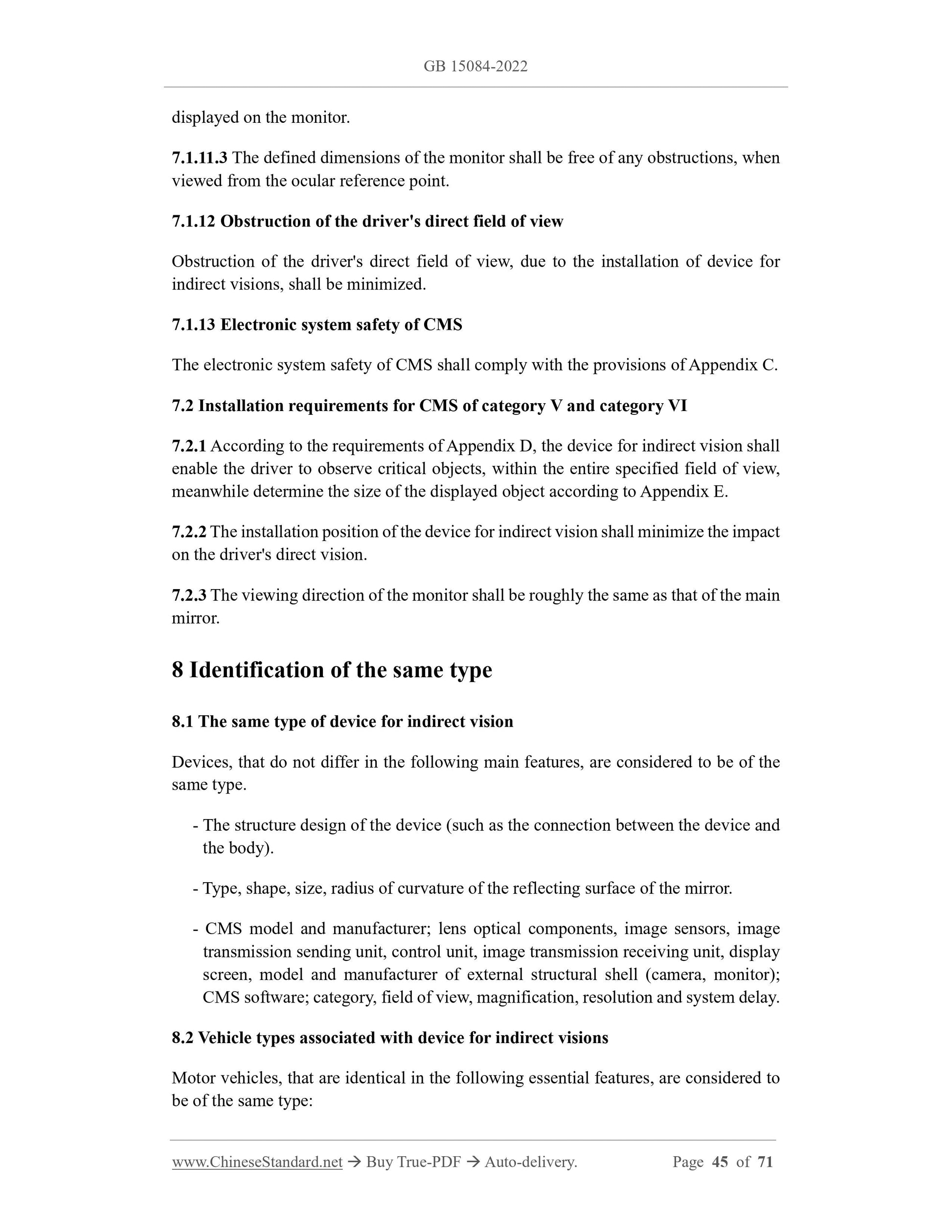1
/
of
12
www.ChineseStandard.us -- Field Test Asia Pte. Ltd.
GB 15084-2022 English PDF
GB 15084-2022 English PDF
Regular price
$695.00
Regular price
Sale price
$695.00
Unit price
/
per
Shipping calculated at checkout.
Couldn't load pickup availability
GB 15084-2022: Motor vehicles - Devices for indirect vision - Requirements of performance and installation
Delivery: 9 seconds. Download (& Email) true-PDF + Invoice.
Get Quotation: Click GB 15084-2022 (Self-service in 1-minute)
Historical versions (Master-website): GB 15084-2022
Preview True-PDF (Reload/Scroll-down if blank)
GB 15084-2022
GB
NATIONAL STANDARD OF THE
PEOPLE’S REPUBLIC OF CHINA
ICS 43.040.60
CCS T 26
Replacing GB 15084-2013
Motor vehicles - Devices for indirect vision - Requirements
of performance and installation
ISSUED ON: DECEMBER 29, 2022
IMPLEMENTED ON: JULY 01, 2023
Issued by: State Administration for Market Regulation;
Standardization Administration of PRC.
Table of Contents
Foreword ... 3
1 Scope ... 5
2 Normative references ... 5
3 Terms and definitions ... 5
4 Technical requirements ... 9
5 Test method ... 22
6 Installation requirements ... 28
7 CMS installation requirements ... 40
8 Identification of the same type ... 45
9 Transition period for implementation ... 46
Appendix A (Normative) Test method of reflectivity ... 47
Appendix B (Normative) Test method for radius of curvature of mirror reflecting
surface ... 53
Appendix C (Normative) Test methods and safety provisions for CMS of category I to
category IV ... 55
Appendix D (Normative) Calculation of detection distance for CMS of category V and
category VI ... 65
Appendix E (Normative) Determination of CMS display object size of category V and
category VI ... 69
Motor vehicles - Devices for indirect vision - Requirements
of performance and installation
1 Scope
This document specifies the technical requirements, test methods, installation
requirements, identification of the same type of device for indirect visions for category
M and category N, as well as the category L motor vehicles, which have at least a
partially enclosed cab.
This document applies to device for indirect visions for motor vehicles of category M
and category N, as well as the category L with at least a partially enclosed cab.
2 Normative references
The contents of the following documents constitute the essential provisions of this
document through normative references in the text. Among them, for dated references,
only the version corresponding to the date applies to this document; for undated
references, the latest version (including all amendments) applies to this document.
GB 11552 The interior fittings of passenger car
GB 34660 Road vehicles - Requirements and test methods of electromagnetic
compatibility
ISO 9241-305 Ergonomics of human-system interaction - Part 305: Optical
laboratory test methods for electronic visual displays
ISO 15008 Road vehicles - Ergonomic aspects of transport information and control
systems - Specifications and test procedures for in-vehicle visual presentation
ISO 16505 Road vehicles - Ergonomic and performance aspects of Camera Monitor
Systems - Requirements and test procedures
3 Terms and definitions
The following terms and definitions apply to this document.
3.1
Device for indirect vision
4.2.2.2 Reflecting surfaces and radii of curvature
4.2.2.2.1 Reflecting surfaces
The reflecting surface of the viewing mirror shall be flat or convex. The reflecting
surface is allowed to add an aspheric reflecting surface, BUT the aspherical reflecting
surface is not allowed to use for meeting the field of view requirements of 6.5.
Measure according to the method specified in Appendix A. For the mirror which has
two working modes, it shall be able to correctly identify the color signal of road traffic
when it is in the daytime position AND the reflectivity of the reflecting surface shall
not be less than 40%; the reflectivity of the reflecting surface, in the nighttime position,
shall not be less than 4%. For the mirror, which has only one working mode, the
reflectivity of the reflecting surface shall not be less than 40%.
4.2.2.2.2 Radius of curvature
4.2.2.2.2.1 Use the spherical gauge, which is specified in Appendix B, to measure the
radius of curvature ri, which is parallel to the horizontal direction of the line segment of
length b, AND the radius of curvature ri' perpendicular to the vertical direction of the
line segment of length b, through the center of the reflecting surface. Calculate the
arithmetic mean rp of ri' and ri, rp = (ri + ri')/2.
4.2.2.2.2.2 The difference -- between the radius of curvature -- meets the following
requirements:
a) When the r value of the mirror's reflecting surface is less than 3000 mm, the radius
of curvature ri' OR the difference between ri and rp shall not be greater than 0.15r;
b) When the r value of the mirror's reflecting surface is less than 3000 mm, the
difference between rp and r, at any point, shall not be greater than 0.15r;
c) When the r value of the reflecting surface of the mirror is not less than 3000 mm,
the difference -- between the radius of curvature mentioned in a) and b) -- shall
not be greater than 0.25r.
4.2.2.2.2.3 The additional aspheric reflecting surface, on the reflecting surface, meets
the following requirements:
a) The width of the additional aspherical reflecting surface shall be at least 30 mm;
b) The radius of curvature ri of the additional aspherical part shall not be less than
150 mm.
4.2.2.2.2.4 Measure according to the method specified in Appendix B. The r value of
the reflecting surface meets the following requirements:
a) For category I mirrors (interior mirrors), category II and category III mirrors (main
exterior mirrors), it shall not be less than 1200 mm;
b) For category IV mirrors (wide-angle exterior mirrors) and category V mirrors
(replenishment exterior mirrors), it shall not be less than 300 mm;
c) For category VI mirrors (front mirrors), it shall not be less than 200 mm;
d) For category VII mirrors, it shall not be less than 1000 mm and not more than
1500 mm.
4.3 CMS
4.3.1 General requirements
4.3.1.1 The CMS shall be adjustable, without the use of tools.
4.3.1.2 Install the CMS at the design position, which is specified by the manufacturer.
At any adjustable position, the radius of curvature of the constituent parts c of the
following parts shall not be less than 2.5 mm:
a) All parts of the CMS and components, which are installed inside the vehicle that
can be in contact with a sphere, which has a diameter of 165 mm, including the
part that remains connected to the bracket;
b) All parts of the CMS and components, which are installed outside the vehicle that
can be in contact with a sphere, which has a diameter of 100 mm, including the
part that remains connected to the bracket.
4.3.1.3 Determine the size of the protruding part, according to the method specified in
4.2.1.5. The outer surface, which has a protruding height greater than or equal to 1.5
mm and less than or equal to 5 mm, shall be chamfered; the outer surface, which has a
protruding height greater than 5 mm, shall comply with the requirements of 4.3.1.2.
4.3.1.4 The requirements of 4.3.1.2 do not apply, if the edges of the fixing holes or
recesses, which have a diameter or maximum diagonal length less than 12 mm on the
CMS, have been chamfered.
4.3.1.5 The cylinder, which uses the rotation axis of the CMS as the center of rotation
AND has a radius of 70 mm, shall at least be tangent to the base or body surface, to
which the CMS connector is connected, except for CMS, whose minimum installation
height is higher than 1.8 m.
4.3.1.6 If the Shore hardness of the camera and monitor components is not greater than
60 HA and they are installed on a rigid bracket, the requirements of 4.3.1.2 are only
applicable to the rigid bracket.
4.3.1.7 If the vehicle monitor complies with the provisions of GB 11552, it is deemed
to meet the requirements of 4.3.1.2.
Epred - The predicted flicker energy.
4.3.2.14 Frame rate
Carry out the test, according to the method specified in ISO 16505. The frame rate of
CMS shall be at least 30 Hz; however, the frame rate of CMS shall be at least 15 Hz,
under low light conditions or when the vehicle is running at low speed.
4.3.2.15 Imaging time
At an ambient temperature of 22 °C ± 5 °C, the test shall be carried out, according to
the method specified in ISO 9241-305. The imaging time of the monitor shall be less
than 55 ms.
4.3.2.16 System delay
Under the condition of ambient temperature 22 °C ± 5 °C, carry out the test, according
to the method specified in ISO 16505. The CMS delay time shall be less than 200 ms.
4.3.2.17 Glare caused by high monitor luminance
The luminance of the monitor shall be manually or automatically dimmed at night.
4.3.2.18 Electromagnetic compatibility
The electromagnetic compatibility of the CMS of category I, category II, category III,
category IV shall comply with the provisions of GB 34660.
4.3.3 Functional requirements of CMS of category V and category VI
4.3.3.1 The CMS shall work normally under direct sunlight; the maximum value of the
overexposed area (the area where the luminance contrast drops below 2:1) shall not
exceed 15% of the displayed image.
4.3.3.2 Under various light conditions, the monitor shall meet the minimum contrast
ratio requirements, which are specified in ISO 15008.
4.3.3.3 According to the environmental conditions, the average luminance of the
monitor shall be adjusted manually or automatically.
5 Test method
5.1 General rules for testing
5.1.1 Category I, category II, category III, category IV, category V, category VI device
for indirect visions, as well as the category VII mirrors (same installation method as
category III mirrors) for category L vehicles shall be subject to the test specified in 5.2.
Category VII mirrors with support rods shall be subjected to the test specified in 5.3.
5.1.2 When the vehicle is under the condition of the maximum design total mass,
meanwhile the height of all parts of the device for indirect vision from the ground, at
any adjustable position, is not less than 1.8 m, for device for indirect visions of category
II, category III, category V, category VI, the test specified in 5.2 may be exempted;
however, there shall be a visible mark of 1.8 m.
5.1.3 The height of the device for indirect vision and its connecting parts, from the
ground, is less than 1.8 m. However, the test specified in 5.2 may be exempted, when
the projected width of the vertical cross-section, which is formed by the joint with the
vehicle body, does not exceed the projected width of the vehicle. When the width of the
device for indirect vision, in this vertical cross-sectional projection, exceeds the
projected width of the vehicle, BUT does not exceed the maximum vehicle body width
in the forward driving direction, based on this plane, the test specified in 5.2 may be
exempted.
5.1.4 For the device, that is integrally installed on the vehicle body AND whose angle
between the front rotation area and the longitudinal reference plane of the vehicle does
not exceed 45°, OR the device, which protrudes no more than 100 mm relative to the
periphery of the vehicle body, the test specified in 5.2 may be exempted.
5.2 Impact test
5.2.1 Test device
5.2.1.1 The impact test equipment consists of a sample holder and a pendulum, one of
which is in the plane of the vertical release trajectory. The end of the pendulum is a
rigid ball, which has a diameter of 165 mm ± 1 mm, its surface is covered with a layer
of rubber, which has a Shore hardness of 50 HA and a thickness of 5 mm; an indicator
used to determine the maximum angle of the swing arm in the release plane, the
accuracy of the measurement shall be ±1°. According to the impact requirements
specified in 5.2.2.7, the support used to hold the sample shall be firmly fixed on the test
equipment. The dimensions and design requirements of the test equipment are as shown
in Figure 4.
located within the adjustment range, which is specified by the manufacturer of
the device for indirect vision or the vehicle manufacturer, AND the position that
is most unfavorable to impact rotation;
c) If the device for indirect vision is telescopically adjustable, as relative to its base,
the device for indirect vision shall be adjusted to the position, which is closest to
the base;
d) For the mirror, if the reflecting surface can be adjusted within the protective shell,
the upper corner farthest from the vehicle body shall be adjusted to the position,
where it protrudes the largest from the protective shell.
5.2.2.3 For the mirror, when the pendulum is in the vertical position, both the horizontal
plane and the longitudinal vertical plane, which pass through the center of the rigid ball,
shall pass through the center of the reflecting surface; the longitudinal movement
direction of the pendulum shall be parallel to the longitudinal reference plane of the
vehicle.
5.2.2.4 For CMS, when the pendulum is in the vertical position, the horizontal plane
and longitudinal vertical plane, which pass through the center of the rigid ball, shall
pass through the center of the lens or the center of the transparent protective cover of
the lens. The longitudinal swing direction of the pendulum shall be parallel to the
longitudinal reference plane of the vehicle. For cameras with a protective cover, the
protective cover shall be open, during the impact.
5.2.2.5 When installing and adjusting according to the provisions of 5.2.2.1 and 5.2.2.2,
if the parts of the device for indirect vision limit the return of the rigid ball, the impact
point shall be adjusted, along the direction perpendicular to the rotation axis or the
rotation center, meanwhile it shall meet one of the following requirements:
a) The outer contour of the rigid ball shall at least be tangent to the surface of the
cylinder, which is mentioned in 4.2.1.7;
b) The contact point of the rigid ball is at least 10 mm, from the edge of the reflecting
surface.
5.2.2.6 During the test, make the pendulum fall freely, from an angle of 60° relative to
the vertical line; it hits the device for indirect vision, when the pendulum reaches the
vertical position.
5.2.2.7 The device for indirect vision shall be subjected to impact, under the following
different conditions.
a) Interior mirror:
1) Under the conditions specified in 5.2.2.3 or 5.2.2.5, the rigid ball shall hit the
reflecting surface;
At the poin...
Delivery: 9 seconds. Download (& Email) true-PDF + Invoice.
Get Quotation: Click GB 15084-2022 (Self-service in 1-minute)
Historical versions (Master-website): GB 15084-2022
Preview True-PDF (Reload/Scroll-down if blank)
GB 15084-2022
GB
NATIONAL STANDARD OF THE
PEOPLE’S REPUBLIC OF CHINA
ICS 43.040.60
CCS T 26
Replacing GB 15084-2013
Motor vehicles - Devices for indirect vision - Requirements
of performance and installation
ISSUED ON: DECEMBER 29, 2022
IMPLEMENTED ON: JULY 01, 2023
Issued by: State Administration for Market Regulation;
Standardization Administration of PRC.
Table of Contents
Foreword ... 3
1 Scope ... 5
2 Normative references ... 5
3 Terms and definitions ... 5
4 Technical requirements ... 9
5 Test method ... 22
6 Installation requirements ... 28
7 CMS installation requirements ... 40
8 Identification of the same type ... 45
9 Transition period for implementation ... 46
Appendix A (Normative) Test method of reflectivity ... 47
Appendix B (Normative) Test method for radius of curvature of mirror reflecting
surface ... 53
Appendix C (Normative) Test methods and safety provisions for CMS of category I to
category IV ... 55
Appendix D (Normative) Calculation of detection distance for CMS of category V and
category VI ... 65
Appendix E (Normative) Determination of CMS display object size of category V and
category VI ... 69
Motor vehicles - Devices for indirect vision - Requirements
of performance and installation
1 Scope
This document specifies the technical requirements, test methods, installation
requirements, identification of the same type of device for indirect visions for category
M and category N, as well as the category L motor vehicles, which have at least a
partially enclosed cab.
This document applies to device for indirect visions for motor vehicles of category M
and category N, as well as the category L with at least a partially enclosed cab.
2 Normative references
The contents of the following documents constitute the essential provisions of this
document through normative references in the text. Among them, for dated references,
only the version corresponding to the date applies to this document; for undated
references, the latest version (including all amendments) applies to this document.
GB 11552 The interior fittings of passenger car
GB 34660 Road vehicles - Requirements and test methods of electromagnetic
compatibility
ISO 9241-305 Ergonomics of human-system interaction - Part 305: Optical
laboratory test methods for electronic visual displays
ISO 15008 Road vehicles - Ergonomic aspects of transport information and control
systems - Specifications and test procedures for in-vehicle visual presentation
ISO 16505 Road vehicles - Ergonomic and performance aspects of Camera Monitor
Systems - Requirements and test procedures
3 Terms and definitions
The following terms and definitions apply to this document.
3.1
Device for indirect vision
4.2.2.2 Reflecting surfaces and radii of curvature
4.2.2.2.1 Reflecting surfaces
The reflecting surface of the viewing mirror shall be flat or convex. The reflecting
surface is allowed to add an aspheric reflecting surface, BUT the aspherical reflecting
surface is not allowed to use for meeting the field of view requirements of 6.5.
Measure according to the method specified in Appendix A. For the mirror which has
two working modes, it shall be able to correctly identify the color signal of road traffic
when it is in the daytime position AND the reflectivity of the reflecting surface shall
not be less than 40%; the reflectivity of the reflecting surface, in the nighttime position,
shall not be less than 4%. For the mirror, which has only one working mode, the
reflectivity of the reflecting surface shall not be less than 40%.
4.2.2.2.2 Radius of curvature
4.2.2.2.2.1 Use the spherical gauge, which is specified in Appendix B, to measure the
radius of curvature ri, which is parallel to the horizontal direction of the line segment of
length b, AND the radius of curvature ri' perpendicular to the vertical direction of the
line segment of length b, through the center of the reflecting surface. Calculate the
arithmetic mean rp of ri' and ri, rp = (ri + ri')/2.
4.2.2.2.2.2 The difference -- between the radius of curvature -- meets the following
requirements:
a) When the r value of the mirror's reflecting surface is less than 3000 mm, the radius
of curvature ri' OR the difference between ri and rp shall not be greater than 0.15r;
b) When the r value of the mirror's reflecting surface is less than 3000 mm, the
difference between rp and r, at any point, shall not be greater than 0.15r;
c) When the r value of the reflecting surface of the mirror is not less than 3000 mm,
the difference -- between the radius of curvature mentioned in a) and b) -- shall
not be greater than 0.25r.
4.2.2.2.2.3 The additional aspheric reflecting surface, on the reflecting surface, meets
the following requirements:
a) The width of the additional aspherical reflecting surface shall be at least 30 mm;
b) The radius of curvature ri of the additional aspherical part shall not be less than
150 mm.
4.2.2.2.2.4 Measure according to the method specified in Appendix B. The r value of
the reflecting surface meets the following requirements:
a) For category I mirrors (interior mirrors), category II and category III mirrors (main
exterior mirrors), it shall not be less than 1200 mm;
b) For category IV mirrors (wide-angle exterior mirrors) and category V mirrors
(replenishment exterior mirrors), it shall not be less than 300 mm;
c) For category VI mirrors (front mirrors), it shall not be less than 200 mm;
d) For category VII mirrors, it shall not be less than 1000 mm and not more than
1500 mm.
4.3 CMS
4.3.1 General requirements
4.3.1.1 The CMS shall be adjustable, without the use of tools.
4.3.1.2 Install the CMS at the design position, which is specified by the manufacturer.
At any adjustable position, the radius of curvature of the constituent parts c of the
following parts shall not be less than 2.5 mm:
a) All parts of the CMS and components, which are installed inside the vehicle that
can be in contact with a sphere, which has a diameter of 165 mm, including the
part that remains connected to the bracket;
b) All parts of the CMS and components, which are installed outside the vehicle that
can be in contact with a sphere, which has a diameter of 100 mm, including the
part that remains connected to the bracket.
4.3.1.3 Determine the size of the protruding part, according to the method specified in
4.2.1.5. The outer surface, which has a protruding height greater than or equal to 1.5
mm and less than or equal to 5 mm, shall be chamfered; the outer surface, which has a
protruding height greater than 5 mm, shall comply with the requirements of 4.3.1.2.
4.3.1.4 The requirements of 4.3.1.2 do not apply, if the edges of the fixing holes or
recesses, which have a diameter or maximum diagonal length less than 12 mm on the
CMS, have been chamfered.
4.3.1.5 The cylinder, which uses the rotation axis of the CMS as the center of rotation
AND has a radius of 70 mm, shall at least be tangent to the base or body surface, to
which the CMS connector is connected, except for CMS, whose minimum installation
height is higher than 1.8 m.
4.3.1.6 If the Shore hardness of the camera and monitor components is not greater than
60 HA and they are installed on a rigid bracket, the requirements of 4.3.1.2 are only
applicable to the rigid bracket.
4.3.1.7 If the vehicle monitor complies with the provisions of GB 11552, it is deemed
to meet the requirements of 4.3.1.2.
Epred - The predicted flicker energy.
4.3.2.14 Frame rate
Carry out the test, according to the method specified in ISO 16505. The frame rate of
CMS shall be at least 30 Hz; however, the frame rate of CMS shall be at least 15 Hz,
under low light conditions or when the vehicle is running at low speed.
4.3.2.15 Imaging time
At an ambient temperature of 22 °C ± 5 °C, the test shall be carried out, according to
the method specified in ISO 9241-305. The imaging time of the monitor shall be less
than 55 ms.
4.3.2.16 System delay
Under the condition of ambient temperature 22 °C ± 5 °C, carry out the test, according
to the method specified in ISO 16505. The CMS delay time shall be less than 200 ms.
4.3.2.17 Glare caused by high monitor luminance
The luminance of the monitor shall be manually or automatically dimmed at night.
4.3.2.18 Electromagnetic compatibility
The electromagnetic compatibility of the CMS of category I, category II, category III,
category IV shall comply with the provisions of GB 34660.
4.3.3 Functional requirements of CMS of category V and category VI
4.3.3.1 The CMS shall work normally under direct sunlight; the maximum value of the
overexposed area (the area where the luminance contrast drops below 2:1) shall not
exceed 15% of the displayed image.
4.3.3.2 Under various light conditions, the monitor shall meet the minimum contrast
ratio requirements, which are specified in ISO 15008.
4.3.3.3 According to the environmental conditions, the average luminance of the
monitor shall be adjusted manually or automatically.
5 Test method
5.1 General rules for testing
5.1.1 Category I, category II, category III, category IV, category V, category VI device
for indirect visions, as well as the category VII mirrors (same installation method as
category III mirrors) for category L vehicles shall be subject to the test specified in 5.2.
Category VII mirrors with support rods shall be subjected to the test specified in 5.3.
5.1.2 When the vehicle is under the condition of the maximum design total mass,
meanwhile the height of all parts of the device for indirect vision from the ground, at
any adjustable position, is not less than 1.8 m, for device for indirect visions of category
II, category III, category V, category VI, the test specified in 5.2 may be exempted;
however, there shall be a visible mark of 1.8 m.
5.1.3 The height of the device for indirect vision and its connecting parts, from the
ground, is less than 1.8 m. However, the test specified in 5.2 may be exempted, when
the projected width of the vertical cross-section, which is formed by the joint with the
vehicle body, does not exceed the projected width of the vehicle. When the width of the
device for indirect vision, in this vertical cross-sectional projection, exceeds the
projected width of the vehicle, BUT does not exceed the maximum vehicle body width
in the forward driving direction, based on this plane, the test specified in 5.2 may be
exempted.
5.1.4 For the device, that is integrally installed on the vehicle body AND whose angle
between the front rotation area and the longitudinal reference plane of the vehicle does
not exceed 45°, OR the device, which protrudes no more than 100 mm relative to the
periphery of the vehicle body, the test specified in 5.2 may be exempted.
5.2 Impact test
5.2.1 Test device
5.2.1.1 The impact test equipment consists of a sample holder and a pendulum, one of
which is in the plane of the vertical release trajectory. The end of the pendulum is a
rigid ball, which has a diameter of 165 mm ± 1 mm, its surface is covered with a layer
of rubber, which has a Shore hardness of 50 HA and a thickness of 5 mm; an indicator
used to determine the maximum angle of the swing arm in the release plane, the
accuracy of the measurement shall be ±1°. According to the impact requirements
specified in 5.2.2.7, the support used to hold the sample shall be firmly fixed on the test
equipment. The dimensions and design requirements of the test equipment are as shown
in Figure 4.
located within the adjustment range, which is specified by the manufacturer of
the device for indirect vision or the vehicle manufacturer, AND the position that
is most unfavorable to impact rotation;
c) If the device for indirect vision is telescopically adjustable, as relative to its base,
the device for indirect vision shall be adjusted to the position, which is closest to
the base;
d) For the mirror, if the reflecting surface can be adjusted within the protective shell,
the upper corner farthest from the vehicle body shall be adjusted to the position,
where it protrudes the largest from the protective shell.
5.2.2.3 For the mirror, when the pendulum is in the vertical position, both the horizontal
plane and the longitudinal vertical plane, which pass through the center of the rigid ball,
shall pass through the center of the reflecting surface; the longitudinal movement
direction of the pendulum shall be parallel to the longitudinal reference plane of the
vehicle.
5.2.2.4 For CMS, when the pendulum is in the vertical position, the horizontal plane
and longitudinal vertical plane, which pass through the center of the rigid ball, shall
pass through the center of the lens or the center of the transparent protective cover of
the lens. The longitudinal swing direction of the pendulum shall be parallel to the
longitudinal reference plane of the vehicle. For cameras with a protective cover, the
protective cover shall be open, during the impact.
5.2.2.5 When installing and adjusting according to the provisions of 5.2.2.1 and 5.2.2.2,
if the parts of the device for indirect vision limit the return of the rigid ball, the impact
point shall be adjusted, along the direction perpendicular to the rotation axis or the
rotation center, meanwhile it shall meet one of the following requirements:
a) The outer contour of the rigid ball shall at least be tangent to the surface of the
cylinder, which is mentioned in 4.2.1.7;
b) The contact point of the rigid ball is at least 10 mm, from the edge of the reflecting
surface.
5.2.2.6 During the test, make the pendulum fall freely, from an angle of 60° relative to
the vertical line; it hits the device for indirect vision, when the pendulum reaches the
vertical position.
5.2.2.7 The device for indirect vision shall be subjected to impact, under the following
different conditions.
a) Interior mirror:
1) Under the conditions specified in 5.2.2.3 or 5.2.2.5, the rigid ball shall hit the
reflecting surface;
At the poin...
Share
